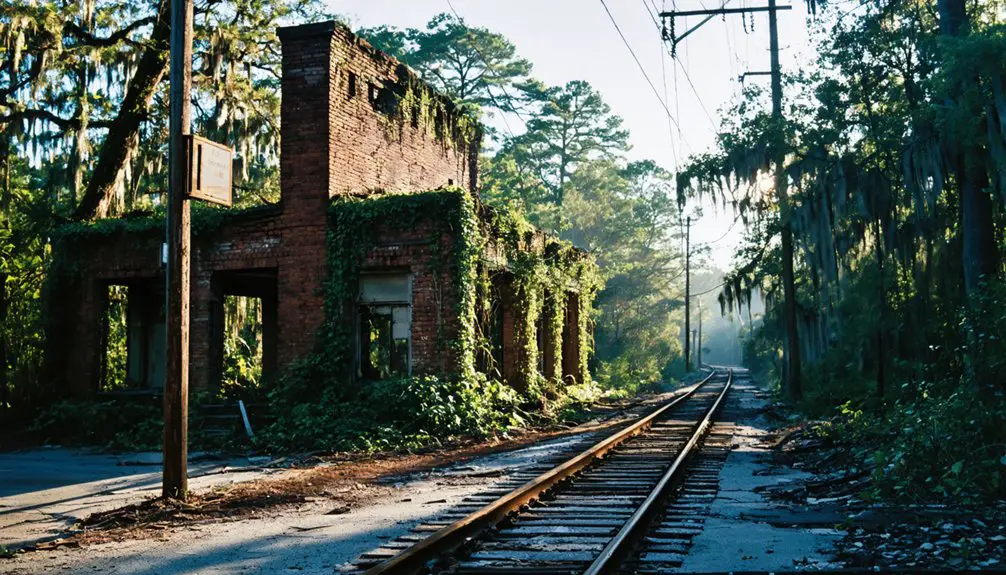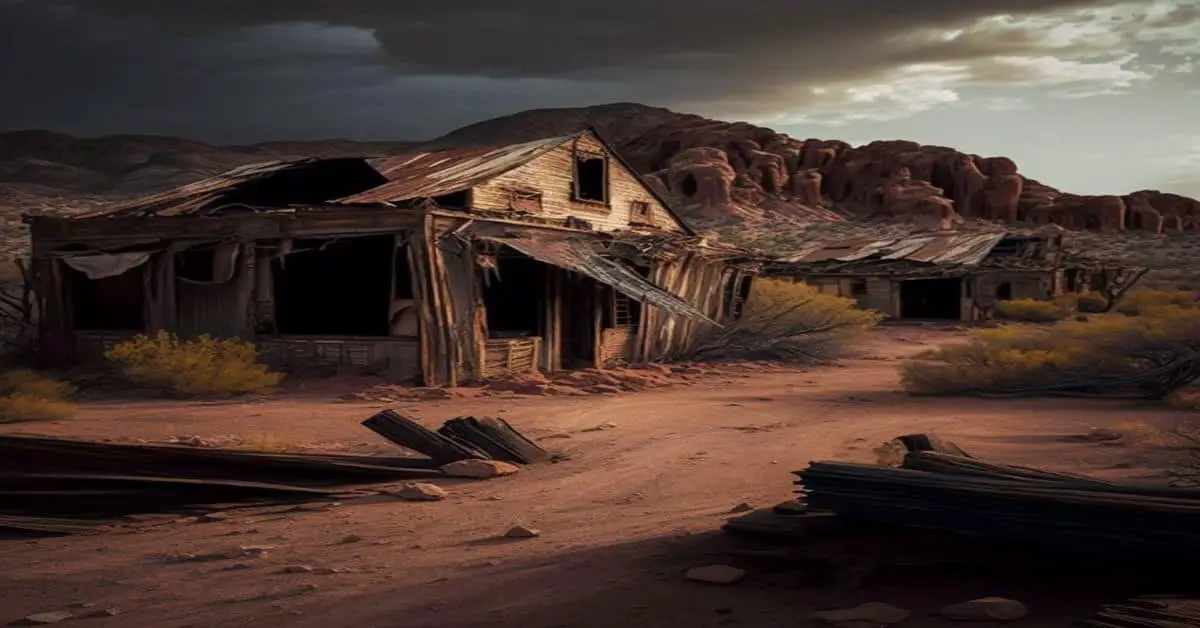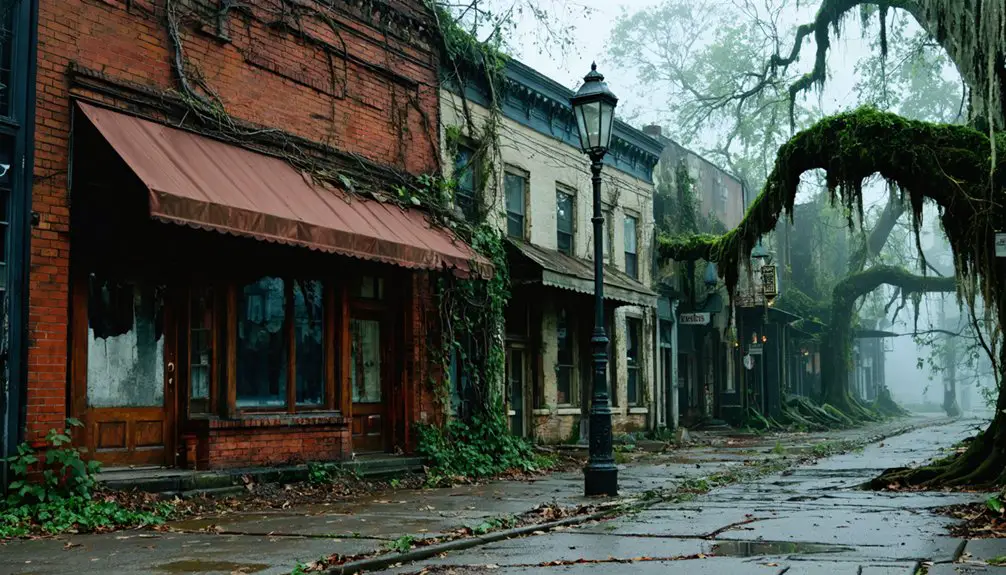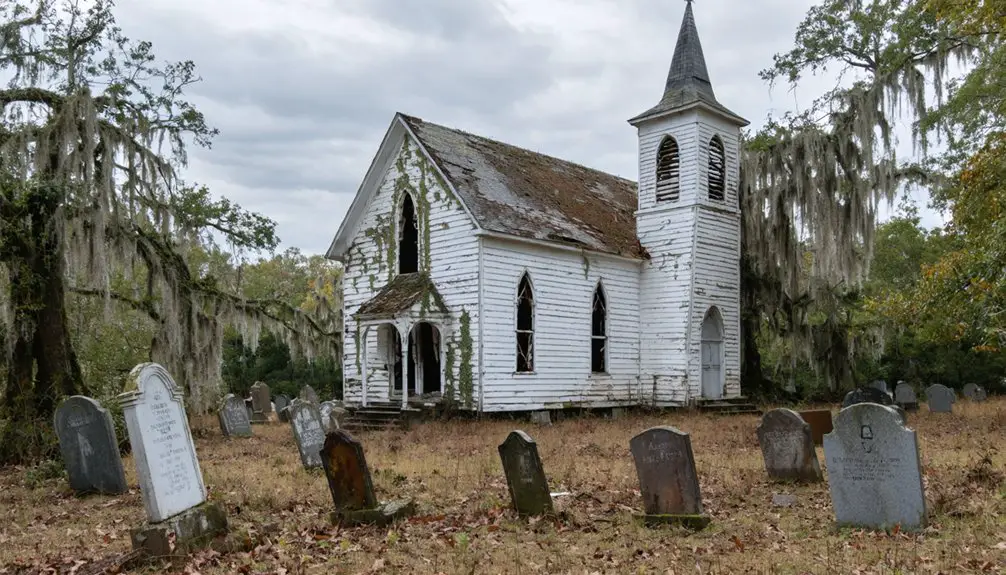You’ll find Dunbarton’s ghost town remnants in South Carolina, where a thriving railroad community of 6,000 residents once prospered through farming and timber. In 1951, the U.S. government acquired 210,000 acres for the Savannah River Plant, forcing families to relocate with inadequate compensation. While physical structures are gone, former residents maintain their heritage through annual reunions since 1952. The story of Dunbarton reveals deeper layers of Cold War sacrifice and community resilience.
Key Takeaways
- Dunbarton became a ghost town in 1951 when the U.S. Atomic Energy Commission acquired 210,000 acres for the Savannah River Plant.
- Nearly 6,000 residents were forcibly relocated, with homes either demolished or physically moved during the government’s nuclear facility development.
- The town’s original layout featured a central railroad station, with surrounding agricultural lands, churches, schools, and approximately 150 cemeteries.
- Former residents maintain connections through annual reunions since 1952, preserving the ghost town’s heritage through storytelling and historical documentation.
- The abandoned town sacrificed its existence for Cold War nuclear priorities, receiving $19 million in compensation deemed below market value.
The Birth of a Railroad Town
While wealthy landowners’ opposition forced the South Carolina Railroad to change its planned route in Barnwell County, this rerouting proved fortuitous for Dunbarton’s development.
You’ll find that Dunbarton’s story began around 1800, but it wasn’t until the railroad’s arrival that the settlement truly flourished.
The railroad’s significance transformed this rural community into a bustling agricultural hub. In the 1880s, the establishment of rail transportation lines sparked tremendous growth in the region.
You’d have seen a typical railroad town layout emerge, with the train station at its heart driving commercial growth.
Like its neighbors Blackville and Bamberg, Dunbarton’s community growth centered on agriculture and rail transport.
The station connected local farmers to broader markets, while supporting essential businesses like cotton gins, grocery stores, and blacksmith shops that served the town’s growing population.
Sadly, the town was later evacuated when the Atomic Energy Commission announced plans for a nuclear site in 1950.
Life Before the Nuclear Age
Before the federal government acquired Dunbarton for nuclear development, you’d have found a close-knit agricultural community of about 6,000 residents living on farms and small homesteads.
The local economy thrived on farming and timber extraction, with many Black families caught in the tenant farming system that made it difficult to achieve economic independence.
Despite agricultural and timber success, the tenant farming system trapped many Black families in a cycle of economic dependence.
You’d have seen a vibrant community with churches, schools, and about 150 cemeteries dotting the landscape.
The sandy soil and good drainage supported agricultural practices, while the nearby Savannah River provided essential water.
The railroad station served as a hub for commerce, connecting farmers to broader markets.
Small businesses emerged to serve both locals and travelers, creating a self-sustaining rural Southern town deeply rooted in post-Civil War traditions. The historic Stagecoach Inn, built in 1745, served as a prominent landmark and gathering place for the community. In 1950, the Atomic Energy Commission approved land acquisition, forever changing the fate of this rural community.
The Government’s Purchase and Acquisition
You’ll find that when the U.S. Atomic Energy Commission acquired over 200,000 acres for the Savannah River Plant in 1951, many residents felt the government’s compensation offers were inadequate for their properties and livelihoods.
The “fair market value” payments often failed to account for the true costs of relocating entire homes, farms, and communities within the rushed timeline of just over a year.
Black tenant farmers and sharecroppers were particularly disadvantaged in the compensation process, as many lacked formal property rights despite having worked the land for generations.
This site would go on to become one of the key facilities in America’s nuclear arsenal, producing 40% of plutonium used in Cold War weapons.
Historical records sometimes show alternative spelling Dunbarton in documentation related to the town’s acquisition, though Dumbarton is considered the correct form.
Land Value Controversy
During the early 1950s, the South Atlantic Division of the Corps of Engineers launched a massive land acquisition effort that would forever change Dunbarton’s landscape.
You’ll find the government’s land valuation process quickly became a source of heated controversy. While officials paid $19 million for approximately 210,000 acres, residents argued the timber value alone was worth at least $28 million at that time.
The acquisition triggered a severe housing shortage as displaced residents sought new homes in surrounding areas.
Compensation disputes erupted as many property owners felt they’d received unfair payment for their land and assets.
Though the government employed appraisers familiar with South Carolina properties, the monetary offers failed to reflect both the economic and sentimental value of what was lost. The Savannah River Plant operations displaced entire families and communities across three hundred square miles of Barnwell County.
If you rejected the initial appraisal offer, you’d face condemnation proceedings in Federal district court, with funds held in escrow.
Relocation Payment Terms
When the federal government initiated land acquisition for the Savannah River Plant in 1950, over 6,000 residents faced mandatory relocation under strict payment terms. You’ll find that the government’s $19 million total payout considerably undervalued both land and structures, leading to widespread compensation disputes among displaced families.
The timber value alone was estimated at $28 million, yet residents couldn’t negotiate market-based prices for their properties. Instead, they’d to accept the government’s fixed appraisals.
These relocation difficulties extended beyond monetary concerns – you’d see entire communities uprooted, with homes either demolished or physically moved. The development displaced multiple historic towns, including nuclear development sites at Meyers Mill. While the government offered some families prefabricated houses in newly established areas like New Ellenton, many struggled with the financial burden of rebuilding their lives after receiving inadequate compensation for their original properties. The displaced residents of Old Dunbarton were among those forced to abandon their homes to make way for the nuclear site’s development.
A Community Uprooted
When the U.S. government acquired Dunbarton in 1951, you’d have witnessed nearly 6,000 residents forced to leave their homes, farms, and businesses behind as the Savannah River Plant took shape.
The emotional impact on displaced families ran deep as they watched their community dismantled, with roughly 150 graveyards exhumed and buildings either demolished or relocated.
Yet you’ll find the spirit of Dunbarton lives on through annual reunions, held since 1952, where former residents gather to maintain their cherished connections and preserve their shared history.
Government Acquisition and Displacement
As President Harry S. Truman approved the Savannah River Plant‘s construction in 1950, the government set its sights on acquiring 300 square miles of South Carolina land, including your town of Dunbarton.
You and nearly 6,000 other residents faced mandatory displacement as the government purchased 210,000 acres for $19 million – considerably less than the timber value alone.
The loss of community heritage was profound as you watched homes demolished, 150 graveyards relocated, and cherished landmarks erased.
While officials claimed national security necessitated these actions, the lack of government transparency left many of you feeling shortchanged and pressured to sell quickly.
You’d find yourself relocated to hastily-built towns like New Ellenton, where despite new housing, the deep-rooted connections of your original community couldn’t be replicated.
Emotional Toll of Relocation
The abrupt displacement from Dunbarton inflicted deep emotional wounds that would mark your community for generations.
You watched helplessly as bulldozers demolished your ancestral homes, churches, and even graveyards – physical landmarks that anchored your cultural identity. The emotional trauma of being uprooted rippled through families as you scattered to different locations, severing deep community bonds built over generations.
Your economic stability crumbled as you lost farmlands and businesses, receiving compensation well below market value.
The identity loss went beyond material possessions – it fractured the very fabric of your communal life. Though you’ve maintained connections through annual reunions, the pain of displacement still echoes through generations, a reflection of the profound impact of being forced from your beloved hometown.
Preserving Community Through Memory
Despite physical displacement, Dunbarton’s community spirit lives on through annual reunions that began in 1952 and continue today. These gatherings serve as living memory archives, where former residents share oral histories and preserve their heritage for future generations.
You’ll find the community’s story captured through various forms of documentation. In the early 1990s, thorough surveys collected memories from both white and African-American residents, covering everything from farming practices to social life.
Digital platforms now house photographs, maps, and personal accounts, while works like “Memories of Home” and “The Unexpected Exodus” guarantee these stories won’t be lost. Through community storytelling at reunions and online archives, Dunbarton’s legacy endures, proving that while buildings may vanish, the bonds of community remain unbreakable.
Preserving Memories and Heritage
Preserving memories of Dunbarton became an essential mission for former residents after their forced relocation in the early 1950s.
When homes vanish, memories become treasures – and Dunbarton’s displaced residents made preservation their mission.
You’ll find their commitment to heritage preservation through annual reunions that started in 1952, where both white and African-American community members gather to share stories, photographs, and historical presentations.
Their dedication to collective memory extends beyond gatherings. In the early 1990s, researchers conducted extensive surveys and interviews, documenting everything from agricultural practices to entertainment.
They’ve preserved their heritage through books like “Memories of Home,” oral histories, and archival materials. While the physical town no longer exists, with buildings demolished and graveyards relocated, the community’s spirit lives on through these carefully maintained records and ongoing reunions that continue to this day.
Cold War Priorities and Local Sacrifice
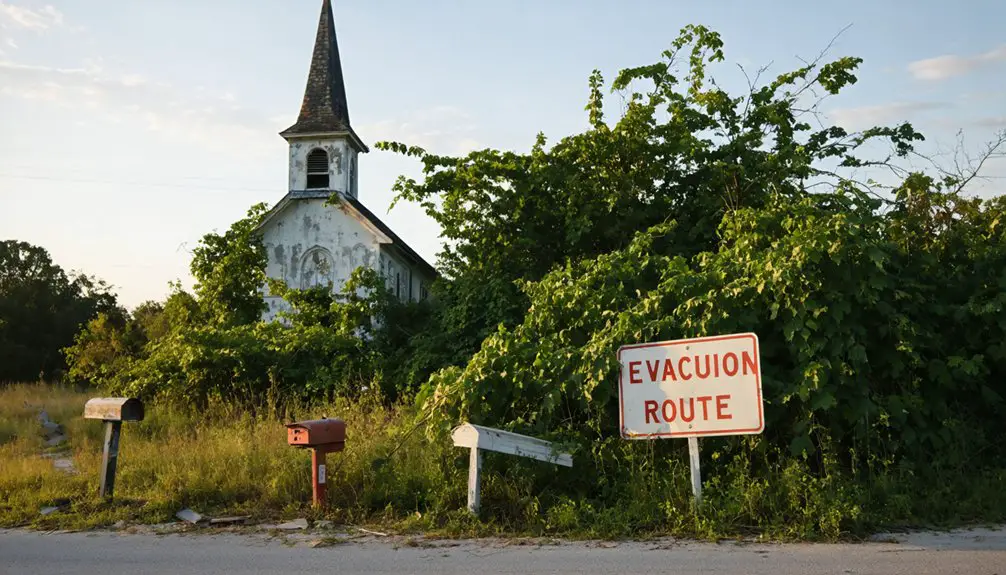
During a pivotal moment in Cold War history, Dunbarton and its neighboring communities made an extraordinary sacrifice for America’s national security objectives.
The federal government’s push for nuclear deterrence led to the construction of the massive Savannah River Plant, forever changing the landscape of rural South Carolina.
Your community’s ancestors faced these unprecedented challenges:
- Nearly 1,500 families were forced to leave their homes with just over a year’s notice.
- Over 210,000 acres were seized for just $19 million, well below market value.
- 150 graveyards required relocation of deceased loved ones.
- Entire towns were dismantled or demolished.
Despite these hardships, you’ll find stories of community resilience as displaced residents adapted to life in New Ellenton, contributing to America’s Cold War defense strategy while preserving their cultural bonds.
Frequently Asked Questions
Are There Any Remaining Structures From Dunbarton Visible at the Site Today?
In 1950, over 150 buildings stood there, but today you won’t find any maintained structures. A remnants assessment shows the site preservation isn’t possible since it’s within the restricted Savannah River Site.
What Happened to the Railroad Tracks That Once Served Dunbarton?
You’ll find the railroad tracks were dismantled when the Atomic Energy Commission acquired the area in 1951, marking the end of this crucial transportation link’s impact on local railroad history.
Can Former Residents Visit Their Old Home Sites Within SRS Boundaries?
You can’t freely visit your old property since access is strictly controlled within SRS boundaries. You’ll need special permits, which are rarely granted, though community memories live on through annual reunions.
How Much Did Individual Families Receive for Their Properties During Relocation?
Like a David versus Goliath tale, you’d find compensation details vary widely by family. While the government promised fair market value, records don’t show exact amounts families received during their forced exodus.
Were Any Historic Artifacts Recovered Before Dunbarton’s Buildings Were Demolished?
You’ll find limited evidence of pre-demolition artifact recovery, though archaeological surveys since the 1980s have documented some items. The demolition impact likely destroyed many historic artifacts before systematic collection could occur.
References
- https://cityofdust.blogspot.com/2005/02/dead-towns-south-carolina.html
- https://strangetalespodcast.wordpress.com/2007/04/09/ellenton-sc-a-town-no-more/
- https://en.wikipedia.org/wiki/Dunbarton
- http://wikimapia.org/15417867/Old-Dunbarton-SC
- https://www.bcvm.org/Dunbarton/
- https://www.rootsandrecall.com/barnwell/history/
- https://en.wikipedia.org/wiki/Meyers_Mill
- https://www.williston-sc.com/history/savannah-river-site/
- https://en.wikipedia.org/wiki/Savannah_River_Site
- https://www.southerncultures.org/article/monuments-for-the-interim-twenty-four-thousand-years/
